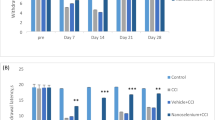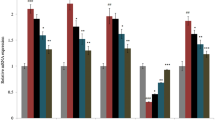Abstract
Chronic exposure to carbon disulfide (CS2) can induce polyneuropathy in occupational worker and experimental animals, but underlying mechanism for CS2 neurotoxicity is currently unknown. In the present study, male Wistar rats were randomly divided into two experimental groups and one control group. The rats in two experimental groups were treated with CS2 by gavage at dosages of 300 and 500 mg/kg per day, respectively, five times per week for 12 weeks. The contents of neurofilament triplet proteins (NF-H, NF-M, NF-L) and two calpain isoforms (m-calpain and u-calpain) in sciatic nerves were determined by immunoblotting. In the meantime, the mRNA levels of NF-H, NF-M and NF-L in spinal cords were quantified by reverse transcriptase-polymerase chain reaction, and the total activity of calpains in sciatic nerves was measured by fluorescence assay. Results showed that the contents of NF-M and NF-L in CS2-treated rats sciatic nerves increased significantly except NF-M in low dose group. The contents and activity of m-calpain and u-calpain in sciatic nerve also demonstrated a significant elevation. Furthermore, the levels of mRNA expression of NFH, NFM and NFL genes were up-regulated consistently in spinal cords of treated rats. These findings suggested that CS2 intoxication was associated with the disruption of neurofilaments homeostasis and activiation of calpains in rat sciatic nerves, which might be involved in the development of CS2-induced peripheral neuropathy.





Similar content being viewed by others
References
Banik NL, Hogan EL, Powers JM, Whetstine LJ (1982) Degradation of cytoskeletal proteins in spinal cord injury. Neurochem Res 7:1465–1475
Banik NL, Matzelle DC, Gantt-Wilford G, Osborne A, Hogan EL (1997) Increased calpain content and progressive degradation of neurofilament protein in spinal cord injury. Brain Res 752:301–306
Beauchamp RO, Bus JS, Popp JA, Boreiko CJ, Goldberg L (1983) A critical review of the literature on carbon disulfide toxicity. Crit Rev Toxicol 11(3):169–278
Ching GY, Liem RK (1993) Assembly of type IV neuronal intermediate filaments in nonneuronal cells in the absences of preexisting cytoplasmic intermediate filaments. J Cell Biol 122:1323–1335
Chiu FC, Norton WT (1982) Bulk preparation of CNS cytoskeleton and the separation of individual neurofilament proteins by gel filtration: dye-binding characteristics and amino acid compositions. J Neurochem 39:1252–1260
Chu CC, Huang CC, Chen RS, Shih TS (1995) Carbon disulfide induced polyneuropathy in viscose rayon workers. Occup Environ Med 52:404–407
Cleveland DW, Monteiro MJ, Wong PC, Gill SR, Gearhart JD, Hoffman PN (1991) Involvement of neurofilaments in the radial growth of axons. J Cell Sci Suppl 15:85–95
Colombi A, Maroni M, Picchi E, Rota E, Castano P, Foa V (1981) Carbon disulfide neuropathy in rats. A morphological and ultra structural study of degeneration and regeneration. Clin Toxicol 18:1463–1474
Gottfried MR, Graham DG, Morgan M, Cases HW, Bus JS (1985) The morphology of carbon disulfide neurotoxicity. Neurotoxicology 6(4):89–96
Graham DG, Amarnath V, Valentine WM, Pyle SJ, Anthony DC (1995) Pathogenetic studies of hexane and carbon disulfide neurotoxicity. Crit Rev Toxicol 25(2):91–112
Guo-Ross S, Yang E, Bondy SC (1998) Elevation of cerebral proteases after systemic administration of aluminum. Neurochem Int 33(3):277–282
Gupta RP, Abou-Donia MB (1996) Alterations in the neutral proteinase activities of central and peripheral nervous systems of acrylamide-, carbon disulfide-, or 2, 5-hexanedione-treated rats. Mol Chem Neuropathol 29(1):53–66
Gupta RP, Abdel-Rahman A, Jensen KF, Abou-Donia MB (2000) Altered expression of neurofilament subunits in diisopropyl phosphorofluoridate-treated hen spinal cord and their presence in axonal aggregations. Brain Res 878(1–2):32–47
Hisanaga S, Hirokawa N (1990) Dephosphorylation-induced interaction of neurofilaments with microtubules. J Biol Chem 265:21852–21858
Hoffman PN, Lasek RJ (1975) The slow component of axonal transport. Identification of major structural polypeptides of the axon and their generality among mammalian neurons. J Cell Biol 66:351–366
Hoffman PN, Cleveland DW, Griffin JW, Landes PW, Cowan NJ, Price DL (1987) Neurofilament gene expression: a major determinant of axonal caliber. Proc Natl Acad Sci USA 84:3472–3476
Julien JP (1999) Neurofilament functions in health and disease. Curr Opin Neurobiol 9:554–560
Lee MK, Cleveland DW (1996) Neuronal intermediate filaments. Annu Rev Neurosci 19:187–217
Lee MK, Xu Z, Wong PC, Cleveland DW (1993) Neurofilaments are obligate heteropolymers in vivo. J Cell Biol 122:1337–1350
Lehning EJ, Persaud A, Dyer KR, Jortner BS, LoPachin RM (1998) Biochemical and morphologic characterization of acrylamide peripheral neuropathy. Toxicol Appl Pharmacol 151(2):211–221
LoPachin RM, He D, Reid ML (2005) 2, 5-Hexanedione-induced changes in the neurofilament subunit pools of rat peripheral nerve. Neurotoxicology 26(2):229–240
Moser VC, Phillips PM, Morgan DL, Sills RC (1998) Carbon disulfide neurotoxicity in rats: VII. Behavioral evaluations using a functional observational battery. Neurotoxicology 19(1):147–157
Nixon RA (1998) Dynamic behavior and organization of cytoskeletal proteins in neurons: reconciling old and new findings. Bioessays 20:798–807
Peters HA, Levine RL, Matthews CG, Sauter SL, Rankin JH (1982) Carbon disulfide-induced neuropsychiatric changes in grain storage workers. Am J Ind Med 3:373–391
Peters HA, Levine RL, Matthews CG, Chapman LJ (1988) Extrapyramidal and other neurological manifestations associated with carbon disulfide fumigant exposure. Arch Neurol 45:537–540
Ray SK, Banik NL (2003) Calpain and its involvement in the pathophysiology of CNS injuries and diseases: therapeutic potential of calpain inhibitors for prevention of neurodegeneration. Curr Drug Target CNS Neurol Disord 2:173–189
Shields DC, Schaecher KE, Saido TC, Banik NL (1999) A putative mechanism of demyelination in multiple sclerosis by a proteolytic enzyme, calpain. Proc Natl Acad Sci USA 96:11486–11491
Sills RC, Harry GJ, Morgan DL, Valentine WM, Graham DG (1998) Carbon disulfide neurotoxicity in rats: V. Morphology of axonal swelling in the muscular branch of the posterior tibial nerve and spinal cord. Neurotoxicology 19:117–127
Song F, Zhao X, Zhou G, Zhu Y, Xie K (2006a) Carbon disulfide-induced alterations of neurofilaments and calpains content in rat spinal cord. Neurochem Res 31(12):1491–1499
Song FY, Yu SF, Zhao XL, Zhang CL, Xie KQ (2006b) Carbon disulfide-induced changes in cytoskeleton protein content of rat cerebral cortex. Neurochem Res 31:71–79
Tsuda M, Tashiro T, Komiya Y (1997) Increased solubility of high molecular mass neurofilament subunit by suppression of dephosphorylation: its relation to axonal transport. J Neurochem 68:2558–2565
Yu S, Zhao X, Zhang T, Yu L, Li S, Cui N, Han X, Zhu Z, Xie K (2005) Acrylamide-induced changes in the neurofilament protein of rat cerebrum fractions. Neurochem Res 30(9):1079–1085
Yu S, Son F, Yu J, Zhao X, Yu L, Li G, Xie K (2006) Acrylamide alters cytoskeletal protein level in rat sciatic nerves. Neurochem Res 31(10):1197–1204
Acknowledgments
This work was supported by grants from the Ministry of Science and Technology of China (No.2002CB512907), and National Natural Science Fund of China (No. 271138).
Author information
Authors and Affiliations
Corresponding author
Rights and permissions
About this article
Cite this article
Song, F., Zhang, C., Wang, Q. et al. Alterations in neurofilaments content and calpains activity of sciatic nerve of carbon disulfide-treated rats. Arch Toxicol 83, 587–594 (2009). https://doi.org/10.1007/s00204-008-0399-2
Received:
Accepted:
Published:
Issue Date:
DOI: https://doi.org/10.1007/s00204-008-0399-2




